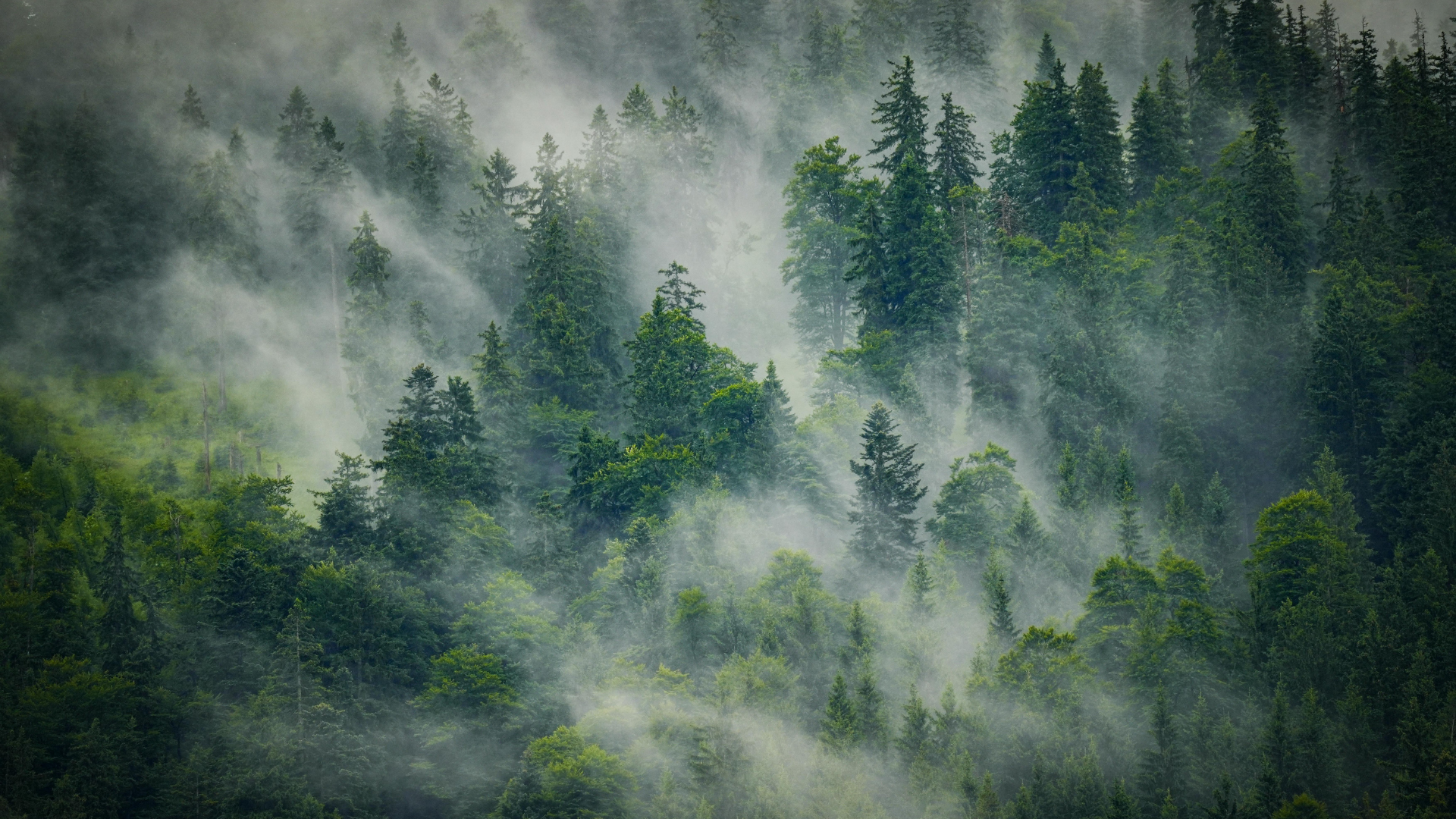.
.
Native Plant Gardening Series Summary
Native plants are naturally adapted to our local growing conditions. They require less water than many non-native plants and grow well without the use of fertilizers or pesticides. These beautiful native plants will give your garden year-round appeal for people and for wildlife –including birds, bees, and butterflies!
.
In case you missed our weekly posts on facebook, here’s a summary of our top picks for beautiful native plants that create habitat for local wildlife.
.
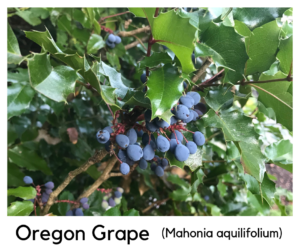 Oregon Grape (Mahonia aquilifolium) is an excellent choice for the low-maintenance gardener looking for a plant that offers four-season rewards. This deer-resistant shrub adapts well to most conditions from sun to shade, and will be tolerant to a hot summer drought. Its shiny, evergreen foliage adds some winter appeal to a mostly dormant garden.
Oregon Grape (Mahonia aquilifolium) is an excellent choice for the low-maintenance gardener looking for a plant that offers four-season rewards. This deer-resistant shrub adapts well to most conditions from sun to shade, and will be tolerant to a hot summer drought. Its shiny, evergreen foliage adds some winter appeal to a mostly dormant garden.
Often by April or May, intense bursts of yellow flowers emerge, adding to the aesthetic appeal of your native plant garden, and providing an early food source for hummingbirds and insect pollinators. The purple berries that follow are food for birds and other small animals. It will grow up to 2.5 meters tall and about 1.5 meters wide, but can be expected to slowly spread via suckers, which can be easily controlled with a good pair of pruners.
.
 Salmonberry (Rubus spectabilis) is a common shrub found in the forests of the Fraser Valley, and is the perfect fit for a naturalized home garden. Out in the forest, you’ll find it growing in moist areas beside streams or wetlands with dappled shade, up to a height of 4 meters tall. Its spreading roots allow this shrub to grow quite densely, creating a woody thicket loved by small animals looking for habitat that gives them a place to hide from larger predators.
Salmonberry (Rubus spectabilis) is a common shrub found in the forests of the Fraser Valley, and is the perfect fit for a naturalized home garden. Out in the forest, you’ll find it growing in moist areas beside streams or wetlands with dappled shade, up to a height of 4 meters tall. Its spreading roots allow this shrub to grow quite densely, creating a woody thicket loved by small animals looking for habitat that gives them a place to hide from larger predators.
Showy pink flowers open in April, and are enjoyed by pollinators and hummingbirds looking for an early food source. Its delicious fruits are some of the earliest to ripen, feeding wildlife from as early as May, and into late July. The berries are a favourite of many birds including, jays, grouse, robins, thrushes, waxwings. Small mammals also enjoy the red berries, and some will even eat the bark and leaves.
.
 Red flowering currant (Ribes sanguineum) promises to give your garden its first splash of colour after a dull winter. Its fragrant pink-to-red flowers provide an early spring food source for hummingbirds, bees and other pollinators. The dark berries are a favourite of our native small mammals and birds. As a low maintenance shrub, it doesn’t mind moist soils, but is also known for its tolerance to drought during the drier months.
Red flowering currant (Ribes sanguineum) promises to give your garden its first splash of colour after a dull winter. Its fragrant pink-to-red flowers provide an early spring food source for hummingbirds, bees and other pollinators. The dark berries are a favourite of our native small mammals and birds. As a low maintenance shrub, it doesn’t mind moist soils, but is also known for its tolerance to drought during the drier months.
When choosing a garden location to plant your Red flowering currant, keep in mind that it will do the best in an area with plenty of sun, but that will also be shaded at some points throughout the day. You can expect this shrub to grow 1-3 meters tall and 2.1 meters wide, making it a good choice as a backdrop at the far side of your garden, or as a natural privacy shrub in the summer.
.
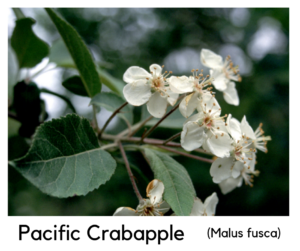 The Pacific Crabapple is fairly compact compared to other tree species native to Coastal BC. Growing slowly up to a mature height of 12m tall and about 8m wide, this tree provides good cover for the ground below, giving both people and wildlife a place to get out of the sun or rain. This tree appreciates a wetter garden site with a fair amount of sun exposure. Gardeners will be pleased to find that this tree adds beauty to any landscape three seasons of the year.
The Pacific Crabapple is fairly compact compared to other tree species native to Coastal BC. Growing slowly up to a mature height of 12m tall and about 8m wide, this tree provides good cover for the ground below, giving both people and wildlife a place to get out of the sun or rain. This tree appreciates a wetter garden site with a fair amount of sun exposure. Gardeners will be pleased to find that this tree adds beauty to any landscape three seasons of the year.
Fragrant white flowers fill the tree from April to May, providing a stunning visual appeal, and food for pollinators in the spring. Late summer weather ripens the tree’s small fruits. Certain bird species such as the beautiful varied thrush, look forward to this abundant summer food source. As autumn sets in, the leaves change to yellow or red, adding to the colour and feel of the season.
.
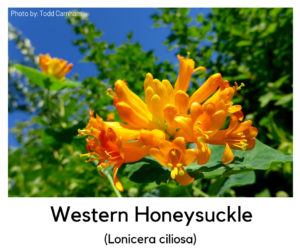 Western Honeysuckle (Lonicera ciliosa) is the native, trailing vine you’ve been looking for to replace the invasive English Ivy (planted years ago by someone with very good intentions) which, by now, is probably taking over your entire garden and perhaps the old forest behind your house. Slow to establish, but prolific once it does, Western honeysuckle will spread out up to 20 feet, and can be trained to climb a trellis with ease.
Western Honeysuckle (Lonicera ciliosa) is the native, trailing vine you’ve been looking for to replace the invasive English Ivy (planted years ago by someone with very good intentions) which, by now, is probably taking over your entire garden and perhaps the old forest behind your house. Slow to establish, but prolific once it does, Western honeysuckle will spread out up to 20 feet, and can be trained to climb a trellis with ease.
It blooms in clusters of sweet-smelling orange flowers from May to June, which are loved by both butterflies and hummingbirds. The red berries begin to ripen in September and are eaten by a variety of birds, including robins and finches. Although it is known to be drought tolerant once established, Western Honeysuckle prefers to be planted in a moist location with lots of shade.
.
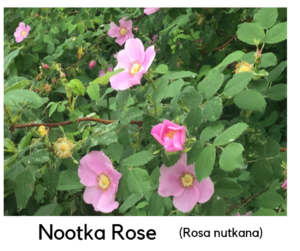 Anyone who grows roses knows that they can be very particular, requiring specific care and master pruning skills. One of BC’s native roses, the Nootka Rose (Rosa nutkana), is an easy-to-grow, ecologically supportive alternative to a non-native cultivar. Its fragrant pink-to-red flowers, a favorite food source of bees and hummingbirds, bloom in June and July.
Anyone who grows roses knows that they can be very particular, requiring specific care and master pruning skills. One of BC’s native roses, the Nootka Rose (Rosa nutkana), is an easy-to-grow, ecologically supportive alternative to a non-native cultivar. Its fragrant pink-to-red flowers, a favorite food source of bees and hummingbirds, bloom in June and July.
Nootka Rose is a fast growing plant, reaching 0.5-3m in height if given the proper growing conditions. Over time it will spread underground to fill the space in which it’s planted, creating a thicket that will support small mammals and birds. It prefers a sunny location but will tolerate shade, and likes moist, well drained soil. However, living up to its reputation as an easy-to-grow species, will also grow in drier conditions.
.
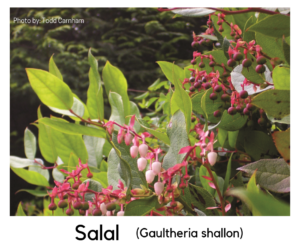 Salal (Gaultheria shallon) is the native relative of the commonly used landscape plant Wintergreen (Gaultheria procumbens). As an evergreen shrub known for its versatility and hardiness, Salal thrives in the full range of sun exposures, preferring soil that stays somewhat moist, but will easily tolerate periods of drought.
Salal (Gaultheria shallon) is the native relative of the commonly used landscape plant Wintergreen (Gaultheria procumbens). As an evergreen shrub known for its versatility and hardiness, Salal thrives in the full range of sun exposures, preferring soil that stays somewhat moist, but will easily tolerate periods of drought.
Its white- to-pink spring flowers attract hummingbirds, while the red summer berries provide food for many varieties of wildlife. This plant tends to grow quite slowly, eventually reaching up to 1.5 meters tall, and continues to spread as it grows, if given the space. The thicket created by this spreading habit is the favoured habitat of small mammals and birds looking to find respite from their larger and often hungry predators.
.
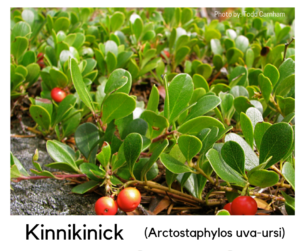 Kinnikinnick (Arctostaphylos uva-ursi), also known as bearberry, is a great choice for a gardener looking for a native groundcover. Growing in well-drained soils with sun to part shade, this plant will stay under half a meter tall but spread widely, filling a space with its evergreen foliage. In the fall, the berries turn wine-red and stay on the plant into the winter, creating a visually festive feel, and providing wildlife with food during scarcer months. The leaves are also enjoyed by some small birds and mammals looking for a quick snack as they forage for more substantial sustenance.
Kinnikinnick (Arctostaphylos uva-ursi), also known as bearberry, is a great choice for a gardener looking for a native groundcover. Growing in well-drained soils with sun to part shade, this plant will stay under half a meter tall but spread widely, filling a space with its evergreen foliage. In the fall, the berries turn wine-red and stay on the plant into the winter, creating a visually festive feel, and providing wildlife with food during scarcer months. The leaves are also enjoyed by some small birds and mammals looking for a quick snack as they forage for more substantial sustenance.
Kinnikinnick can be used as an ally in areas prone to erosion. As it spreads across the site, its roots take hold of the soil, preventing it from washing away during heavy rain events. The mat of foliage it creates also provides a year-round habitat for other small critters. .
.
To learn more about native plant gardening, take a look at our Native Plant Gardening Guide:
Gardening with Native Plants in the lower Mainland and Fraser Valley!
.
Want to get wildife-friendly gardening tips right to your inbox? Sign up for our e-newsletter The Valley Steward!
.
.
.
.
.
.



